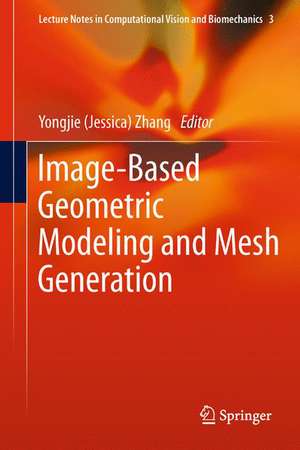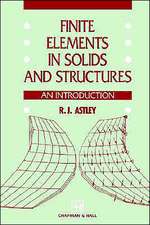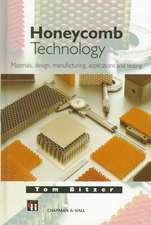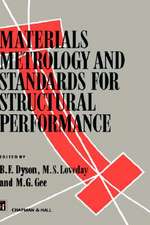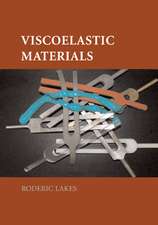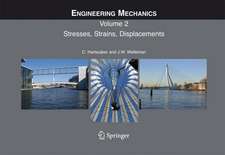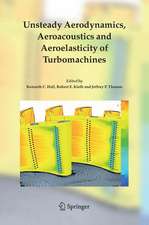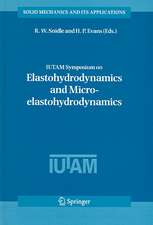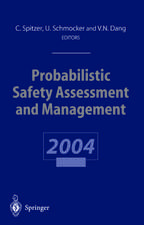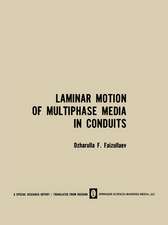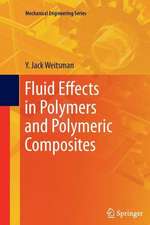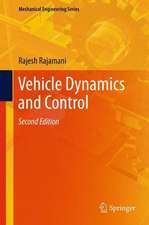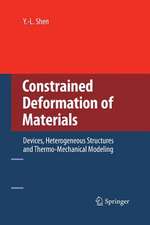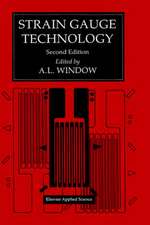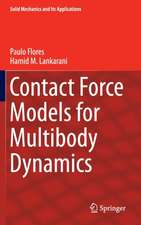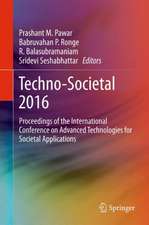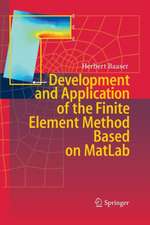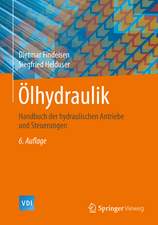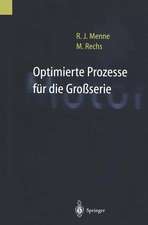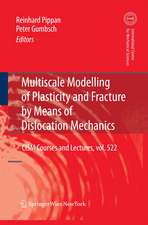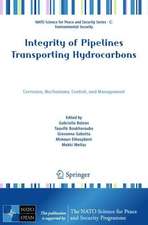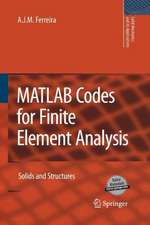Image-Based Geometric Modeling and Mesh Generation: Lecture Notes in Computational Vision and Biomechanics, cartea 3
Editat de Yongjie (Jessica) Zhangen Limba Engleză Hardback – 3 iul 2012
This contributed volume, the first for such an interdisciplinary topic, collects the latest research by experts in this area. These papers cover a broad range of topics, including medical imaging, image alignment and segmentation, image-to-mesh conversion, quality improvement, mesh warping, heterogeneous materials, biomodelcular modeling and simulation, as well as medical and engineering applications.
This contributed volume, the first for such an interdisciplinary topic, collectsthe latest research by experts in this area. These papers cover a broad range of topics, including medical imaging, image alignment and segmentation, image-to-mesh conversion, quality improvement, mesh warping, heterogeneous materials, biomodelcular modeling and simulation, as well as medical and engineering applications.
This contributed volume, the first for such an interdisciplinary topic, collects the latest research by experts in this area. These papers cover a broad range of topics, including medical imaging, image alignment and segmentation, image-to-mesh conversion, quality improvement, mesh warping, heterogeneous materials, biomodelcular modeling and simulation, as well as medical and engineering applications.
This contributed volume, the first for such an interdisciplinary topic, collects the latest research by experts in this area. These papers cover a broad range of topics, including medical imaging, image alignment and segmentation, image-to-mesh conversion, quality improvement, mesh warping, heterogeneous materials, biomodelcular modeling and simulation, as well as medical and engineering applications.
| Toate formatele și edițiile | Preț | Express |
|---|---|---|
| Paperback (1) | 561.30 lei 38-44 zile | |
| SPRINGER NETHERLANDS – 23 aug 2016 | 561.30 lei 38-44 zile | |
| Hardback (1) | 652.31 lei 6-8 săpt. | |
| SPRINGER NETHERLANDS – 3 iul 2012 | 652.31 lei 6-8 săpt. |
Din seria Lecture Notes in Computational Vision and Biomechanics
- 15%
 Preț: 651.19 lei
Preț: 651.19 lei - 5%
 Preț: 734.38 lei
Preț: 734.38 lei - 5%
 Preț: 1103.03 lei
Preț: 1103.03 lei - 5%
 Preț: 724.50 lei
Preț: 724.50 lei - 5%
 Preț: 714.63 lei
Preț: 714.63 lei - 20%
 Preț: 344.42 lei
Preț: 344.42 lei - 5%
 Preț: 720.10 lei
Preț: 720.10 lei - 5%
 Preț: 367.64 lei
Preț: 367.64 lei - 5%
 Preț: 731.43 lei
Preț: 731.43 lei - 15%
 Preț: 648.05 lei
Preț: 648.05 lei - 5%
 Preț: 725.07 lei
Preț: 725.07 lei - 5%
 Preț: 374.20 lei
Preț: 374.20 lei - 5%
 Preț: 735.11 lei
Preț: 735.11 lei - 5%
 Preț: 729.42 lei
Preț: 729.42 lei - 15%
 Preț: 647.40 lei
Preț: 647.40 lei - 5%
 Preț: 1100.30 lei
Preț: 1100.30 lei - 5%
 Preț: 374.57 lei
Preț: 374.57 lei - 15%
 Preț: 642.68 lei
Preț: 642.68 lei - 5%
 Preț: 380.80 lei
Preț: 380.80 lei - 5%
 Preț: 375.70 lei
Preț: 375.70 lei - 24%
 Preț: 888.75 lei
Preț: 888.75 lei -
 Preț: 483.05 lei
Preț: 483.05 lei - 20%
 Preț: 569.86 lei
Preț: 569.86 lei - 5%
 Preț: 647.55 lei
Preț: 647.55 lei -
 Preț: 355.15 lei
Preț: 355.15 lei - 18%
 Preț: 971.32 lei
Preț: 971.32 lei -
 Preț: 363.67 lei
Preț: 363.67 lei - 5%
 Preț: 1122.42 lei
Preț: 1122.42 lei - 5%
 Preț: 1168.30 lei
Preț: 1168.30 lei - 5%
 Preț: 1031.90 lei
Preț: 1031.90 lei - 5%
 Preț: 1104.32 lei
Preț: 1104.32 lei - 5%
 Preț: 721.77 lei
Preț: 721.77 lei
Preț: 652.31 lei
Preț vechi: 767.42 lei
-15% Nou
Puncte Express: 978
Preț estimativ în valută:
124.84€ • 129.85$ • 103.06£
124.84€ • 129.85$ • 103.06£
Carte tipărită la comandă
Livrare economică 15-29 aprilie
Preluare comenzi: 021 569.72.76
Specificații
ISBN-13: 9789400742543
ISBN-10: 9400742541
Pagini: 300
Ilustrații: XI, 301 p.
Dimensiuni: 155 x 235 x 25 mm
Greutate: 0.75 kg
Ediția:2013
Editura: SPRINGER NETHERLANDS
Colecția Springer
Seria Lecture Notes in Computational Vision and Biomechanics
Locul publicării:Dordrecht, Netherlands
ISBN-10: 9400742541
Pagini: 300
Ilustrații: XI, 301 p.
Dimensiuni: 155 x 235 x 25 mm
Greutate: 0.75 kg
Ediția:2013
Editura: SPRINGER NETHERLANDS
Colecția Springer
Seria Lecture Notes in Computational Vision and Biomechanics
Locul publicării:Dordrecht, Netherlands
Public țintă
ResearchCuprins
Challenges and Advances in Image-Based Geometric Modeling and Mesh Generation, by Yongjie Zhang.- 3D Surface Realignment Tracking for Medical Imaging: A Phantom Study with PET Motion Correction , by Oline V. Olesen, Rasmus R. Paulsen, Rasmus R. Jensen, Sune H. Keller, Merence Sibomana, Liselotte Højgaard, Bjarne Roed, and Rasmus Larsen.- Flexible Multi-scale Image Alignment Using B-Spline Reparametrization, by Yanmei Zheng, Zhucui Jing, Guoliang Xu.- Shape based Conditional Random Fields for Segmenting Intracranial Aneurysms, by Sajjad Baloch, Erkang Cheng, and Tong Fang.- Tetrahedral Image-To-Mesh Conversion Approaches For Surgery Simulation and Navigation, by Andrey N. Chernikov, Panagiotis A. Foteinos, Yixun Liu, Michel Audette, Andinet Enquobahrie, and Nikos P. Chrisochoides.- Surface Triangular Mesh and Volume Tetrahedral Mesh Generations for Biomolecular Modelling, by Minxin Chen, Bin Tu and Benzhuo Lu.- A Combined Level Set/Mesh Warping Algorithm for Tracking Brain and Cerebrospinal Fluid Evolution in Hydrocephalic Patients, by Jeonghyung Park, Suzanne M. Shontz, and Corina S. Drapaca.- An Optimization-Based Iterative Approach to Tetrahedral Mesh Smoothing , by Zhanheng Gao, Zeyun Yu, and Jun Wang.- High-Quality Multi-Tissue Mesh Generation for Finite Element Analysis, by Panagiotis A. Foteinos and Nikos P. Chrisochoides.- Construction ofModels and Meshes of Heterogeneous Material Microstructures from Image Data, by Ottmar Klaas, Mark W. Beall, and Mark S. Shephard.- Quality Improvement of Segmented Hexahedral Meshes Using Geometric Flows, by Juelin Leng, Guoliang Xu, Yongjie Zhang, and Jin Qian.- Patient-Specific Model Generation and Simulation for Pre-Operative Surgical Guidance for Pulmonary Embolism Treatment, by Shankar P. Sastry, Jibum Kim, Suzanne M. Shontz, Brent A. Craven, Frank C. Lynch, Keefe B. Manning, and Thap Panitanarak.- Computational Techniques for Analysis of Shape and Kinematics of Biological Structures, by Jia Wu and John C. Brigham.- Finite Element Modeling of Biomolecular Systems in Ionic Solution, by Benzhuo Lu.
Textul de pe ultima copertă
As a new interdisciplinary research area, “image-based geometric modeling and mesh generation” integrates image processing, geometric modeling and mesh generation with finite element method (FEM) to solve problems in computational biomedicine, materials sciences and engineering. It is well known that FEM is currently well-developed and efficient, but mesh generation for complex geometries (e.g., the human body) still takes about 80% of the total analysis time and is the major obstacle to reduce the total computation time. It is mainly because none of the traditional approaches is sufficient to effectively construct finite element meshes for arbitrarily complicated domains, and generally a great deal of manual interaction is involved in mesh generation.
This contributed volume, the first for such an interdisciplinary topic, collects the latest research by experts in this area. These papers cover a broad range of topics, including medical imaging, image alignment and segmentation, image-to-mesh conversion, quality improvement, mesh warping, heterogeneous materials, biomodelcular modeling and simulation, as well as medical and engineering applications.
This contributed volume, the first for such an interdisciplinary topic, collects the latest research by experts in this area. These papers cover a broad range of topics, including medical imaging, image alignment and segmentation, image-to-mesh conversion, quality improvement, mesh warping, heterogeneous materials, biomodelcular modeling and simulation, as well as medical and engineering applications.
This contributed volume, the first for such an interdisciplinary topic, collects the latest research by experts in this area. These papers cover a broad range of topics, including medical imaging, image alignment and segmentation, image-to-mesh conversion, quality improvement, mesh warping, heterogeneous materials, biomodelcular modeling and simulation, as well as medical and engineering applications.
This contributed volume, the first for such an interdisciplinary topic, collects the latest research by experts in this area. These papers cover a broad range of topics, including medical imaging, image alignment and segmentation, image-to-mesh conversion, quality improvement, mesh warping, heterogeneous materials, biomodelcular modeling and simulation, as well as medical and engineering applications.
Caracteristici
Shows the current state-of-the-art of image-based modeling points out the future directions in the field of Mesh Generation Includes various novel algorithms developed to solve different problems Includes many interesting application examples Includes supplementary material: sn.pub/extras
